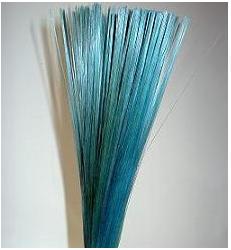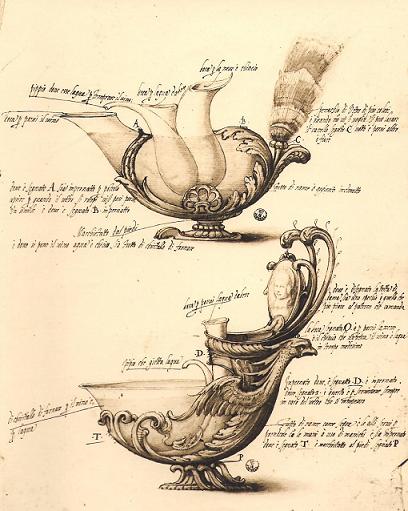Storia del vetro di Murano
I tessuti in vetro filato dei perlai veneziani dell'Ottocento
The glass cloth produced by nineteenth century Venetian bead-makers

Nel Cinquecento i lavoratori “a lume” toscani facevano certamente vetro filato: se ne ha la prova nei “pennacchi” che abbelliscono alcuni vetri disegnati dal pittore Jacopo Ligozzi. Probabilmente lo facevano anche i “supialume” veneziani.
La tessitura del vetro filato, probabilmente cominciata in Francia, si sviluppò a Venezia dopo il 1830, per opera di Carlo Olivi. Egli utilizzava per l'orditura fili di rame o d'argento e quindi non otteneva certamente tessuti molto flessibili. Poi Benedetto Polacco abbinò i fili di vetro alla canapa e riuscì a tessere tappezzerie di grandi dimensioni servendosi della mano d'opera della Pia Casa di Ricovero. Il più bravo fu Jacopo Tommasi, che dal 1840, per una trentina d'anni, vinse tantissimi premi alle Esposizioni che erano di moda in quel secolo, con “cestelli, piatti, vasi, cappelli, paralumi” e scatole e cornici rivestite di tessuto di vetro filato.

In the sixteenth century tuscan glass artisans certainly produced spun glass; the "plumes" that decorate some glass works designed by the painter Jacopo Ligozzi orovide proof of this fact. It is also probable that Venetian bead-makers did very much the same. The production of glass cloth most likely began in France and was further developed in Venice after 1830, thanks to the work of Carlo Olivi. He would use cooper or silver threads for warping and thus did not create very flexible cloth. Later, Benedetto Placco combined glass threads with cannabis and was able to weave large scale tapestries thanks to craftsmanship provided by the Pia Casa di Ricovero. Jacopo Tommasi was an especially skilled craftsman whose carrer began 1840. He worked for more than 30 years, earning himself numerous prizes at the specialised Exhibitions that were very in vogue during the nineteenth century, thanks to his "baekets, plates, vases, hats and lampshades" as well as boxes and frames covered with glass cloth



Paolo Zecchin Via Cappuccina 13 Mestre Venezia
The glass cloth produced by nineteenth century Venetian bead-makers

Nel Cinquecento i lavoratori “a lume” toscani facevano certamente vetro filato: se ne ha la prova nei “pennacchi” che abbelliscono alcuni vetri disegnati dal pittore Jacopo Ligozzi. Probabilmente lo facevano anche i “supialume” veneziani. La tessitura del vetro filato, probabilmente cominciata in Francia, si sviluppò a Venezia dopo il 1830, per opera di Carlo Olivi. Egli utilizzava per l'orditura fili di rame o d'argento e quindi non otteneva certamente tessuti molto flessibili. Poi Benedetto Polacco abbinò i fili di vetro alla canapa e riuscì a tessere tappezzerie di grandi dimensioni servendosi della mano d'opera della Pia Casa di Ricovero. Il più bravo fu Jacopo Tommasi, che dal 1840, per una trentina d'anni, vinse tantissimi premi alle Esposizioni che erano di moda in quel secolo, con “cestelli, piatti, vasi, cappelli, paralumi” e scatole e cornici rivestite di tessuto di vetro filato.
In the sixteenth century tuscan glass artisans certainly produced spun glass; the "plumes" that decorate some glass works designed by the painter Jacopo Ligozzi orovide proof of this fact. It is also probable that Venetian bead-makers did very much the same. The production of glass cloth most likely began in France and was further developed in Venice after 1830, thanks to the work of Carlo Olivi. He would use cooper or silver threads for warping and thus did not create very flexible cloth. Later, Benedetto Placco combined glass threads with cannabis and was able to weave large scale tapestries thanks to craftsmanship provided by the Pia Casa di Ricovero. Jacopo Tommasi was an especially skilled craftsman whose carrer began 1840. He worked for more than 30 years, earning himself numerous prizes at the specialised Exhibitions that were very in vogue during the nineteenth century, thanks to his "baekets, plates, vases, hats and lampshades" as well as boxes and frames covered with glass cloth
